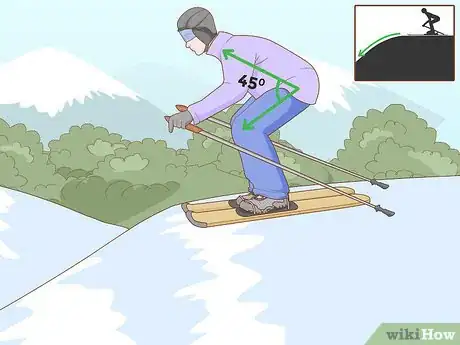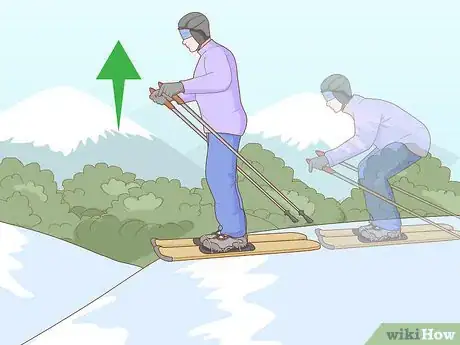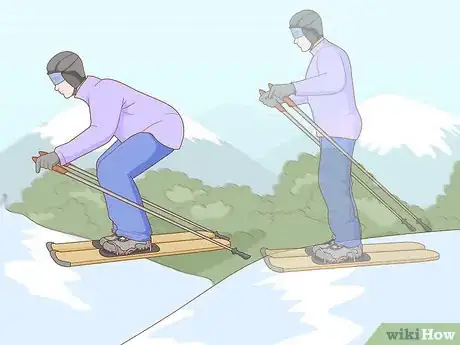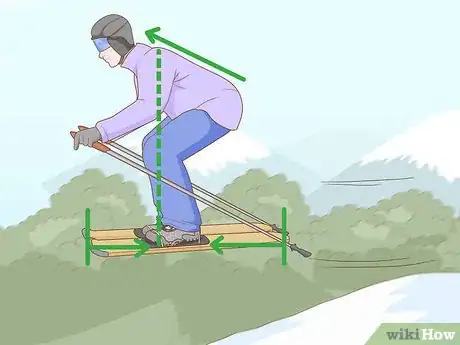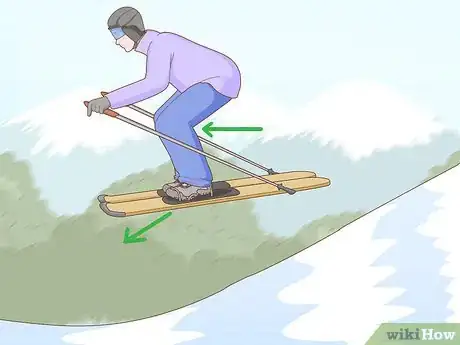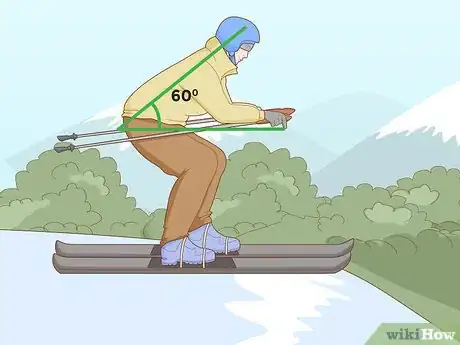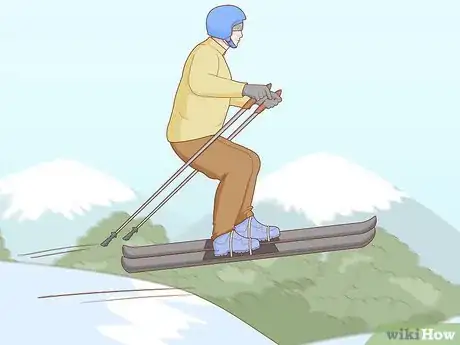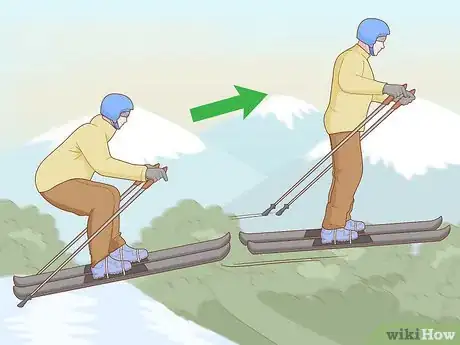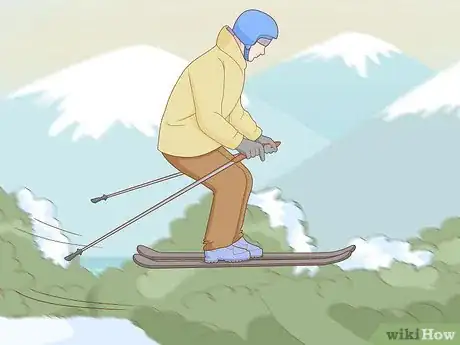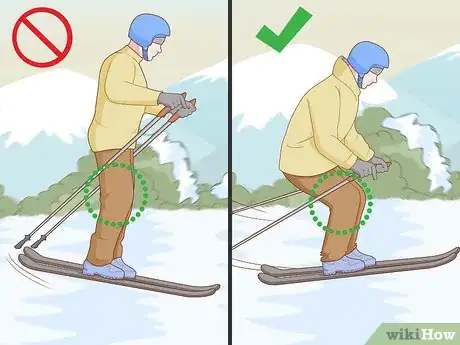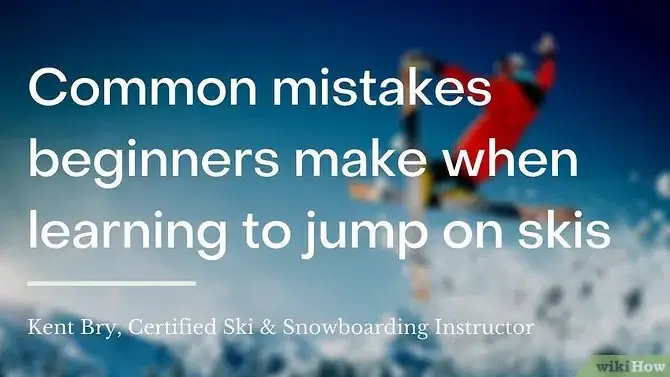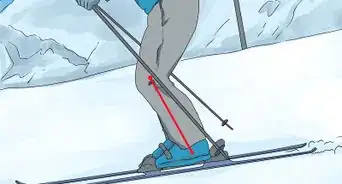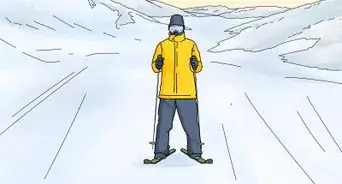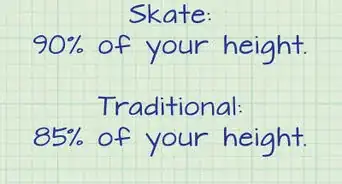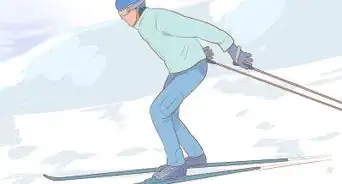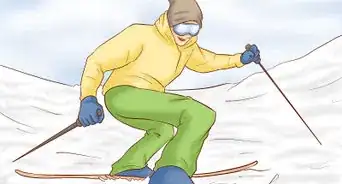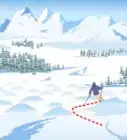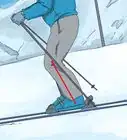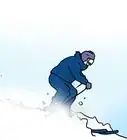This article was co-authored by Kent Bry. Kent Bry is a certified ski and snowboarding instructor and the director of Adventure Ski & Snowboard, a school based in the San Diego, California metro area. With over 50 years of skiing and snowboarding performance and instruction experience, Kent is certified by the Professional Ski Instructors of America (PSIA). Adventure Ski & Snowboard is a member of the PSIA and the American Association of Snowboard Instructors (AASI). Kent holds a BS in Recreational Therapy from San Diego State University and is also a California-registered recreational therapist.
This article has been viewed 21,162 times.
If you're learning to ski, jumping can seem like an intimidating process. But with a bit of practice, you can start learning the springing technique and—when you're comfortable—move on to the more difficult ollie. Both are great ways to learn how to jump, improve your technique, and take your skiing to the next level!
Steps
Learning to Spring
-
1Bend your knees and hips forward as you approach the slope. Gradually bend them forward until your back and legs create a 45-degree angle. Ideally, you want your back to be pointing upward in front of you by the time you need to spring off the lip (or edge) of the jump.[1]
- Keep your body weight over the center of the skis.[2]
-
2Extend your body upwards as you approach the lip. The goal of the spring is to jump and extend your body upwards to create enough upward momentum to take you airborne. To accomplish this, straighten your knees and hips into a standing position while jumping up in one smooth motion. Just remember to ensure that your body is straight just as the center of your skis touch the lip of the jump—this will maximize your time in the air.[3]
- Push down on the snow to create momentum as you throw your body upwards.
- If you can't get enough time in the air, you might be jumping too early or too late.
- Get your center of gravity as high as you can right before the jump.
Advertisement -
3Compress your body while airborne. After throwing your body upwards just as you hit the lip, the upward momentum should take you into the air. At this point, crunch your body by bending your knees and hips forward again until your back is in the same 45-degree position as it was before the jump.[4]
- Keep your body weight over the center of your skis.
- Don't make any forward or backward movements or you will throw yourself off balance.[5]
-
4Maintain your weight in the center of the skis as you land. With your body crunched and your knees bent, focus on keeping your center of gravity over the middle of your skis. This is crucial for a solid landing as it prevents you from going off balance and falling when you land.
- Keep your back as straight as possible.
-
5Bend your knees slightly before landing to absorb the impact. As you approach the ground, extend your body again, making sure to keep your knees and hips slightly bent. Touch the ground with the back of your skis first and then flatten them out. After your skis are completely touching the ground, compress your body again by bending your hips and knees forward to absorb the landing impact. Now stand back up straight and continue skiing.[6]
- Maintain your center of gravity over the middle of the skis.
- Lean your body slightly forward as you compress your body to bring your legs closer to your chest.
- Don't completely straighten your body out, as you need a slight bend in your knees to absorb the landing impact.
Practicing the Ollie
-
1Lean forward 60 degrees as you approach the slope. As you approach the slope, lean forward slightly to prepare for the jump. Be sure to keep your body weight centered over the skis and your arms and legs shoulder-width apart.[7]
- Keep your back straight and face directly forward.
-
2Throw your weight backward before the jump. Before hitting the jump, throw your body weight backward to bend your skis and bring their front ends into the air. Keep your back straight and your body weight stable to avoid falling to the left or right, which will throw you off balance.[8]
- Make sure your back and legs create a 90-degree angle.
-
3Lean your weight forward over the lip and jump. While keeping the tips of your skis in the air, lean forwards so that your weight shifts over the point you're jumping off from. Once your weight is directly over it, jump upward and lean forward. Be sure to extend your body straight after you jump.[9]
- Fully extend your body at the same time as the back of your skis touch the jump's lip.
- Apply pressure to the bend on the back (or tail) of your skis as you rise to help spring yourself into the air.
-
4Tuck in your legs and lean forward slightly. This will curb wind resistance and make it easier to maintain your balance. Continue focusing on keeping your body weight over the middle of your skis as much as possible.[10]
- If your body shifts off-center, readjust yourself while in the tucked position.
-
5Keep your knees slightly bent before you land to absorb the impact. Start extending your body as you approach the ground until your knees and hips are only slightly bent. Try to make sure the backs of your skis are the first part to touch the ground before flattening your skis out. Afterward, compress your body by bending your knees and hips forward to absorb the impact when you hit the ground. Now you can steadily stand back up and continue skiing.[11]
- Never completely straighten your body or your hips and knees will be unable to absorb the force of the landing.
- Lean forward as you compress your body to bring your legs to your chest.
- Always keep your weight centered over the middle of the skis.
Expert Q&A
-
QuestionWhat are some common mistakes that beginners make when learning to jump on skis?
 Kent BryKent Bry is a certified ski and snowboarding instructor and the director of Adventure Ski & Snowboard, a school based in the San Diego, California metro area. With over 50 years of skiing and snowboarding performance and instruction experience, Kent is certified by the Professional Ski Instructors of America (PSIA). Adventure Ski & Snowboard is a member of the PSIA and the American Association of Snowboard Instructors (AASI). Kent holds a BS in Recreational Therapy from San Diego State University and is also a California-registered recreational therapist.
Kent BryKent Bry is a certified ski and snowboarding instructor and the director of Adventure Ski & Snowboard, a school based in the San Diego, California metro area. With over 50 years of skiing and snowboarding performance and instruction experience, Kent is certified by the Professional Ski Instructors of America (PSIA). Adventure Ski & Snowboard is a member of the PSIA and the American Association of Snowboard Instructors (AASI). Kent holds a BS in Recreational Therapy from San Diego State University and is also a California-registered recreational therapist.
Certified Ski & Snowboarding Instructor
-
QuestionIs ski jumping dangerous?
 Kent BryKent Bry is a certified ski and snowboarding instructor and the director of Adventure Ski & Snowboard, a school based in the San Diego, California metro area. With over 50 years of skiing and snowboarding performance and instruction experience, Kent is certified by the Professional Ski Instructors of America (PSIA). Adventure Ski & Snowboard is a member of the PSIA and the American Association of Snowboard Instructors (AASI). Kent holds a BS in Recreational Therapy from San Diego State University and is also a California-registered recreational therapist.
Kent BryKent Bry is a certified ski and snowboarding instructor and the director of Adventure Ski & Snowboard, a school based in the San Diego, California metro area. With over 50 years of skiing and snowboarding performance and instruction experience, Kent is certified by the Professional Ski Instructors of America (PSIA). Adventure Ski & Snowboard is a member of the PSIA and the American Association of Snowboard Instructors (AASI). Kent holds a BS in Recreational Therapy from San Diego State University and is also a California-registered recreational therapist.
Certified Ski & Snowboarding Instructor Ski jumps can be dangerous if you go in without any practice. However, if you work on your technique and start with small jumps, jumping can be safe and fun.
Ski jumps can be dangerous if you go in without any practice. However, if you work on your technique and start with small jumps, jumping can be safe and fun.
Things You'll Need
- Skis
- Ski boots
- A helmet is strongly recommended, especially if you are a beginner.
References
- ↑ http://www.mechanicsofsport.com/skiing/how_to_ski/jumping.html
- ↑ Kent Bry. Certified Ski & Snowboarding Instructor. Expert Interview. 14 July 2020.
- ↑ https://youtu.be/CLsAGnYBZMY?t=56
- ↑ http://www.mechanicsofsport.com/skiing/how_to_ski/jumping.html
- ↑ Kent Bry. Certified Ski & Snowboarding Instructor. Expert Interview. 14 July 2020.
- ↑ http://www.mechanicsofsport.com/skiing/how_to_ski/jumping.html
- ↑ http://www.mechanicsofsport.com/skiing/how_to_ski/jumping.html
- ↑ http://www.mechanicsofsport.com/skiing/how_to_ski/jumping.html
- ↑ https://youtu.be/URu9JzbobUE?t=63
- ↑ http://www.mechanicsofsport.com/skiing/how_to_ski/jumping.html
- ↑ https://stompittutorials.com/tutorials/how-to-jump-on-skis-part-1-2/
- ↑ Kent Bry. Certified Ski & Snowboarding Instructor. Expert Interview. 14 July 2020.
- ↑ Kent Bry. Certified Ski & Snowboarding Instructor. Expert Interview. 14 July 2020.
- ↑ https://youtu.be/8gX_jiFG1SM?t=154
About This Article
To do a basic spring on skis, lean forward at a 45-degree angle while bending your knees as you approach the slope. As you get to the lip of the of the jump, straighten your knees and rise to a standing position while jumping up at the same time. Try to time your jump so it happens when the centers of your skis are over the lip. This will create upward momentum and help you stay in the air longer. While you’re in the air, crouch down again like you did at the beginning of your jump, keeping your center of gravity over the middle of your skis. Keep your knees and hips bent as you land, since this will help absorb the impact of your landing. Scroll on for expert advice on how to do an Ollie!
